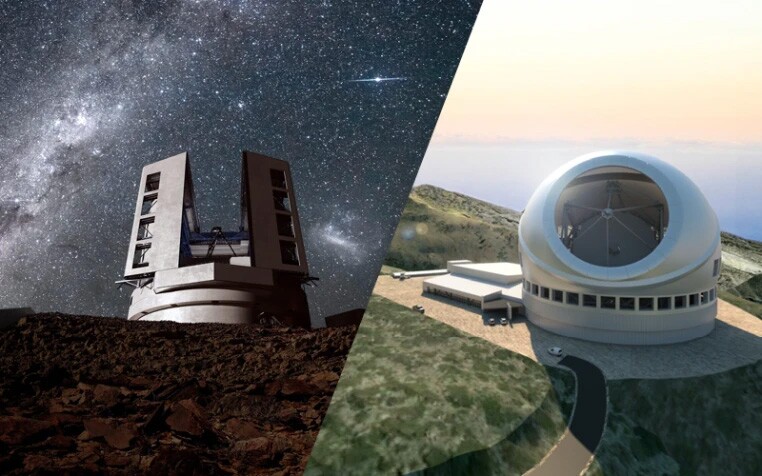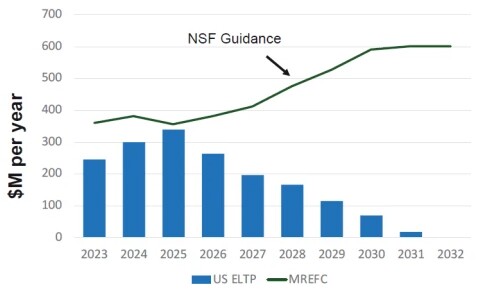NSF likely to drop one of its two planned giant telescopes
DOI: 10.1063/pt.vulb.rbap

Renderings of the Giant Magellan Telescope (left) and the Thirty Meter Telescope. Credits: GMTO Corporation (left); M3 Engineering
This article is adapted from a 1 March
The governing board of NSF has set a $1.6 billion ceiling on the agency’s potential contribution of construction funding for the Thirty Meter Telescope (TMT) in Hawaii and the Giant Magellan Telescope (GMT) in Chile. Announced on 27 February, the decision
In particular, the board has asked NSF to report back by May on “its plan to select which of the two candidate telescopes the Agency plans to continue to support.” Asked for clarification on that statement, a board spokesperson replied, “Based on what the board knows now, it anticipates that a down selection will be necessary.” The spokesperson also said that the board looks forward to getting an update in May on the status of “partner contributions” to the projects.
The GMT has already begun construction
The ultimate arbiter of what will be funded is Congress, which controls NSF’s construction budget on a project-by-project basis. Congressional appropriators have signaled interest in NSF supporting both telescopes, though it’s far from ensured that they will provide the necessary funding to complete both. The final fiscal year 2024 appropriations bill
Relying on NSF
The management teams for the telescopes are far from covering their total costs through partner contributions, which has led to their requests for NSF support. The agency has funded
The GMT’s partner institutions have committed more than $850 million in cash and in-kind contributions toward a total project cost of more than $2.5 billion, according to a spokesperson for the project. The TMT’s partners have contributed cash and in-kind contributions totaling $2 billion, according to a project spokesperson. The spokesperson did not offer an estimate of the total cost of the TMT, stating that the amount is “dependent upon a number of factors, in particular the schedule.”
The $1.6 billion cap set by the NSF board is equal to the level of spending proposed in the latest decadal survey for astronomy and astrophysics
“The success of at least one of these projects is absolutely essential if the United States is to maintain a position as a leader in ground-based astronomy,” the survey argued. It pointed in particular to competition posed by the European Southern Observatory’s under-construction Extremely Large Telescope, which is already more than halfway complete
Aspirations versus reality
The survey presented a notional annual construction funding profile for the TMT and the GMT, which began in 2023 and peaked in 2025 at around $350 million. It assessed that such a profile would be manageable under the aspirational budget scenario that NSF provided to the survey.
So far, NSF’s construction budget has proven to be much more constrained than the aspirational scenario.
Congress allocated $187 million for NSF construction projects in FY 2023. Those funds were split between Antarctic infrastructure modernization, midscale research infrastructure, the Vera C. Rubin Observatory, and detector upgrades at the Large Hadron Collider.

The bars show the notional funding profile for the Extremely Large Telescope Program (ELTP), which manages NSF support for the TMT and the GMT. The line indicates NSF’s aspirational budget for major research equipment and facilities construction (MREFC), which includes not only the US ELTP but also other large-scale projects.
National Academies of Sciences, Engineering, and Medicine
Although the Rubin and Large Hadron Collider projects are near the end of their construction profiles, a huge backlog of infrastructure work remains in Antarctica, and the midscale infrastructure program has proven very popular across scientific disciplines. Both could retain large shares of the construction budget for years to come.
In its FY 2024 budget request, NSF asked Congress to increase the agency’s construction account to $305 million, with nearly $100 million of the increase going to starting a new supercomputer acquisition project. The newly released congressional appropriations bill allocates
The NSF board cautioned in its 27 February announcement that a $1.6 billion contribution to the TMT and the GMT would likely consume most of the agency’s annual budget for construction projects at a time of high demand for new research infrastructure. “The Board recognizes there are compelling [construction] needs across a wide range of science and engineering fields as well as other astronomy needs expressed in the Astro2020 decadal survey,” it explained.
Construction queue increasingly crowded
NSF officials have sought to manage scientists’ expectations of how much construction money will be available.
“I think the community labors under the misapprehension that putting a facility into the very beginning of the design stage implies that NSF is committed to building that facility; that is not the case,” said Denise Caldwell, acting head of NSF’s mathematical and physical sciences (MPS) directorate, at an advisory committee meeting last year. “Anywhere in the design process, the design can be stopped and an off-ramp developed, and the project will never come to construction.”
Caldwell explained that NSF’s process contrasts with that of the Department of Energy, which generally makes a firmer commitment to projects that reach the design stage. She also emphasized that other major projects within the MPS directorate are vying for funds, as are projects from other directorates across NSF.
Ranked just below the TMT and the GMT in priority by the Astro2020 decadal survey are the Cosmic Microwave Background Stage 4 (CMB-S4) project and the next-generation Very Large Array (ngVLA). CMB-S4 is estimated to cost around $800 million,
Notably, particle physicists ranked CMB-S4 as their highest priority
In light of the high demand for infrastructure, the MPS directorate recently formed a task force
The task force recommended that NSF maintain a portfolio of potential projects and review them together as a group. “Adopting this suggestion requires a significant modification of the existing process at NSF and a new vision for infrastructure,” it stated.